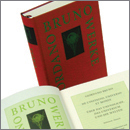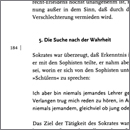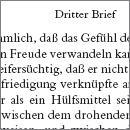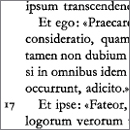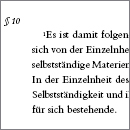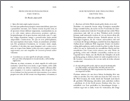Content & form
The design of the publications of the Meiner Verlag
When publishing philosophical texts, irrespective of whether they are monographs, journal articles, anthologies, textbooks, dictionaries, introductions, reference works, study and reading editions, historical-critical editions, ‘Gesammelte Werke’ or 'Last-End Editions', not only the quality of the content but also an appropriate form of the presentation of the works is fundamentally important.
This concerns a) the structure, this means the order, arrangement and shape of the components of the respective edition – for example text and abstract, outline, running title, pagination, line counter, marginalia and apparatus, from introduction, notes, appendix, epilogue and commentary, as well as overviews, glossary, tabs, directories, tables, figures –, which must be added to a reasonable product that promotes the content and b) the technical features of the publication – for example format, typesetting, printing, color, paper, envelopes, embossing, intent, capital volume, head cuts, bookmarks and other orientation aids, inserts, bookbinding and the materials used (coverings, glue, cardboard boxes) –, which significantly affect the durability, utility and aesthetic value of the publication.
The content and form is maintained in all six program areas "Philosophische Bibliothek", "Nachschlagewerke/Lexika", "Monographien/Reihen", "Periodika", "Editionen/Werkausgaben" und "Sonderausgaben", because they determine each other. It is the central task of the scientific publishing house – beyond the dissemination of its publications – to allow readers adequate access to the works of the authors, to ensure an efficient, sustainable and pleasant reading and to consider the specific likes. Precisely the structure, the technique and the aesthetic of the printed publications prove their competitiveness, maybe even the superiority, over other media.
Depending on the type of text, many options are available in the formative preparation and arrangement of the various works. For example, monographs, readings or historic-critical editions have different tools for detailed development. Mandatory are the index, titles, registers and bibliographical references, which clarify the content, structure and its context, enabling a quick introduction to the lecture as well as a further study of the subject. Introduction, notes, editorial references and commentaries provide information on the text-editing and establish the historic-critical relation or introduce into the topic.
Other tools are:
- Types of page counter: page-by-page, sectional or consecutively. They provide a connection between reference point, apparatus, comment or the notes.
- Transfer of the pagination and text separation of various historically important editions in order to make older citations discoverable and to link the edition with different works and researches.
- If possible, apparatus, index and glossaries inform about the textual constitution, sources, parallel passages, process, terminology decisions and the literature used.
Format, binding, materials and many other technical features of a printed work are determined by the requirements of the presentation, the conception of the series – or the single publication –, the intended use and the economic reasons.
For example, the studies editions of the “Philosophische Bibliothek” are released in a convenient format 12,2 cm x 19,0 cm, the historic-critical edition “G. W. F. Hegel, Gesammelte Werke”, which is sophisticatedly manufactured, in representative lexicon format 18,5 cm x 27,5 cm and the volumes of the “Blauen Reihe”, containing indicatory texts of today’s authors, in practical and keen well-priced format 13,0 x 21,0 cm.
The layout, i.e. the arrangement of the main text, pagination, titles, of line counters, marginalia, footnotes, references and other editorial additions are in font, font size, type area, line case etc. adapting to the requirements, with special attention to the readability.
A series title or a monography is subject to different requirements in terms of composition than a studies edition or a historic-critical edition.
Based on the main text all additional elements are placed in grading order to provide an ideal clarity in order to enable an effortless and rapid capture of complex content and relations.
The printing is always implemented by advanced techniques and with the latest materials. Digital printing remains the exception due to not yet sufficient proven durability. Since the 90s – immediately after the introduction of the standard DIN ISO 97016 establishing the criteria for aging resistance – every edition of the publishing house is printed on accordingly conditioned paper, which fibers are made of chlorine-free bleached pulp. Since 2007 our preferred paper supplier certificated his entire commodity to FSC. This means that every material for the paper conforms the requirement of social, ecological and economical aspects in the use of natural resources.
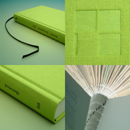 Most printing works published by Meiner are produced in the sophisticated process of thread stitching, which is designed for a special longevity, with exception of magazines and some special editions. Only in special cases adhesive binding or thread seal is used. The choice of adhesives also plays a crucial role in durability and user-friendliness. Usually ‘disperse glue’ is used, being most advantageous.
Most printing works published by Meiner are produced in the sophisticated process of thread stitching, which is designed for a special longevity, with exception of magazines and some special editions. Only in special cases adhesive binding or thread seal is used. The choice of adhesives also plays a crucial role in durability and user-friendliness. Usually ‘disperse glue’ is used, being most advantageous.
Technical features of monographs and series
Extensive research work, which includes – besides periodicals – monographs as well as anthology based on a scientific concept, appear almost without exception in thematically oriented series. Even such publications, which are unfortunately rarely in demand, are carefully proofread and comprehensively edited by the responsible producers. The publication’s layout, arrangement, assignment of footnotes, directories (content, literature, names, etc.) and the addition of other aids to the analysis of the text is the result of discussions and debates with authors and publishers.
Composition, printing and the bookbinding work reflects the scientific quality of the content. Furthermore they provide orientation and should facilitate the reading of the – often difficult – matter. The uniform format of the books is 15,4 cm x 22,9 cm. The volumes of the newly founded “Blaue Reihe” are the exception; their format is the pocket size 13,0 cm x 21,0 cm and are released as a brochures.
The printing is mostly done in the offset process (16 pages per sheet) and predominantly on aging-resistant, yellowish-white, made of chlorine-free bleached pulp with a weight of 80 g/qm and 1.5 times volume ‘Alsterwerkdruckpapier’.
The bindings (usually a cardboard tape with printed cover, thread stitching) are made based on stability and the requirement of the library. The libraries usually want a clear film around the book, that’s why a cloth binding would be wasteful. For the bindery process only disperse glue is used to ensure a long service life and an ideal book-opening-behavior.
Technical features of eBooks
The eBooks of the Felix Meiner Verlag have the same pagination than the specific printed book (thus also scientifically correct usable). They are PDF-based and displayed in an HTML5-reader. Furthermore the eBooks can be read directly without a download in the browser in the Meiner eLibrary. So you have access from any computer around the world with internet access to the eBooks and do not need to download a specific device. Within the Meiner eLibrary you are able to read the eBooks, write notes, compile bookmarks, highlight passages and search for specific words and phrases. The printing and copying of text parts is only permitted in excerpts. Other trade partner (f.e. ciando.com, ebooks.com, etc.) enable the download of eBook-PDFs (protected by Adobe-DRM). For more information please click >> here.



